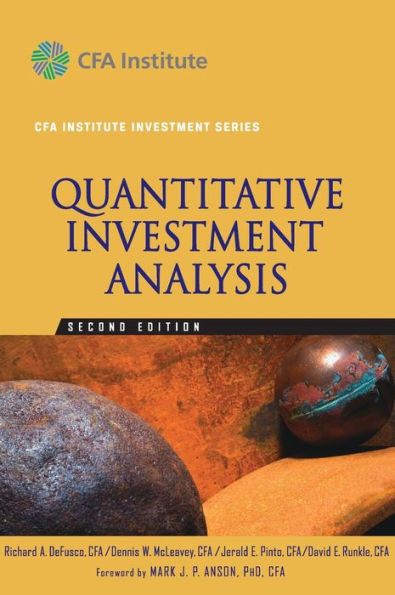Quantitative Investment Analysis / Edition 2 available in Hardcover

Quantitative Investment Analysis / Edition 2
- ISBN-10:
- 0470052201
- ISBN-13:
- 9780470052204
- Pub. Date:
- 01/16/2007
- Publisher:
- Wiley

Quantitative Investment Analysis / Edition 2
Hardcover
Buy New
$50.39Buy Used
$56.59
-
SHIP THIS ITEM— Not Eligible for Free Shipping
-
PICK UP IN STORECheck Availability at Nearby Stores
Available within 2 business hours
-
SHIP THIS ITEM
Temporarily Out of Stock Online
Please check back later for updated availability.
Overview
As part of the CFA Institute Investment Series, the Second Edition of Quantitative Investment Analysis has been designed for a wide range of individuals, from graduate-level students focused on finance to practicing investment professionals. This globally relevant guide will help you understand quantitative methods and apply them to today's investment process.
In this latest edition, the distinguished team of Richard DeFusco, Dennis McLeavey, Jerald Pinto, and David Runkle update information associated with this discipline; improve the presentation and coverage of several major areas, including regression, time series, and multifactor models; and introduce an even greater variety of investment-oriented examples—which reflect the changes currently taking place in the investment community. Throughout the text, special attention is paid to ensuring the even treatment of subject matter, consistency of mathematical notation, and continuity of topic coverage that is so critical to the learning process.
Valuable for self-study and general reference, this book provides clear, example-driven coverage of a wide range of quantitative methods. Topics discussed include:
- The time value of money
- Discounted cash flow applications
- Common probability distributions
- Sampling and estimation
- Hypothesis testing
- Correlation and regression
- Multiple regression and issues in regression analysis
- Time-series analysis
- Portfolio concepts
And to further enhance your understanding of the tools and techniques presented here, don't forget to pick up the Quantitative Investment Analysis Workbook, Second Edition—an essential guide containing learning outcomes and summary overview sections along with challenging problems and solutions.
With each author bringing his own unique experiences and perspectives to the table, the Second Edition of Quantitative Investment Analysis distills the knowledge, skills, and abilities you need to succeed in today's fast-paced financial environment. Filled with in-depth insights and practical advice, Quantitative Investment Analysis, Second Edition offers a comprehensive treatment of quantitative methods that combines best practices with solid theory.

Product Details
| ISBN-13: | 9780470052204 |
|---|---|
| Publisher: | Wiley |
| Publication date: | 01/16/2007 |
| Series: | CFA Institute Investment Series , #2 |
| Edition description: | Revised Edition |
| Pages: | 600 |
| Product dimensions: | 7.30(w) x 9.96(h) x 1.44(d) |
